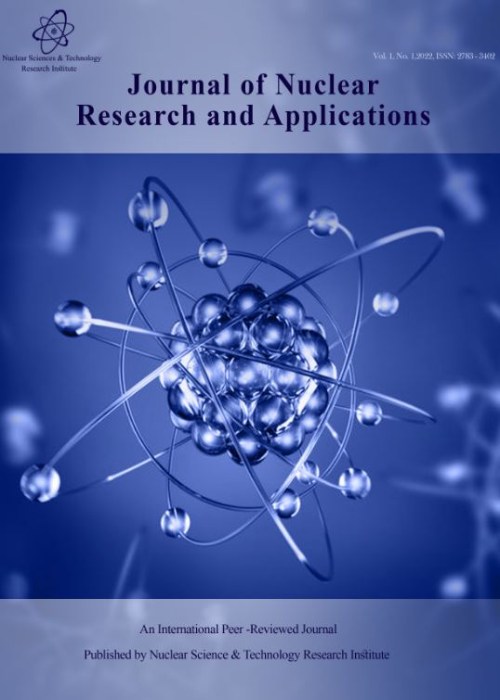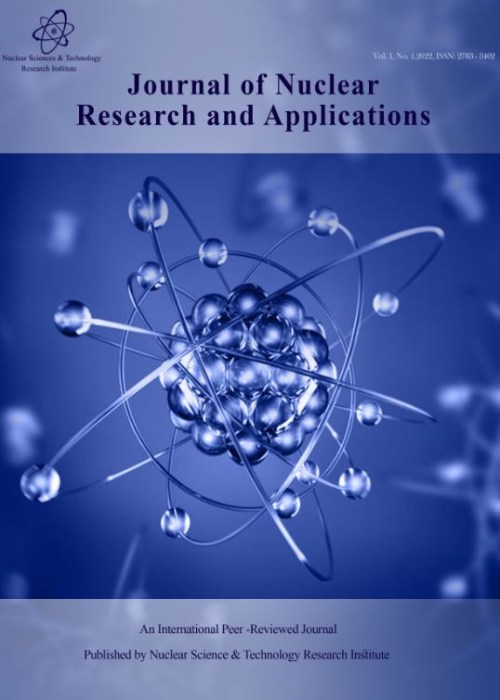فهرست مطالب

Journal of Nuclear Research and Applications
Volume:3 Issue: 4, Autumn 2023
- تاریخ انتشار: 1402/11/12
- تعداد عناوین: 6
-
-
Ab Initio Study of Mechanical and Vibrational Characteristics of Uranium Monoxide in Nuclear ReactorPages 1-11
In this research, the mechanical and phonon properties of UO in the rock-salt phase have been calculated systematically using density functional theory and ab-initio method in projector augmented wave pseudopotentials parameterization. The obtained lattice constant has good accordance with the experimental one at null pressure and temperature. The mechanical stability is confirmed because the positive elastic constants meet the Born-Huang criterion. The mechanical properties including bulk modulus, shear modulus, and Young’s modulus are evaluated using the Voigt-Reuss-Hill approximation. The value of Poisson’s ratio (v) is obtained to be nearly 0.36, which shows that this compound has an ionic bond and interatomic forces within the crystal are central. The elasticity analysis of the Kleinman parameter reveals that bond bending is dominant within the sublattice of UO. The vibrational density of states and phonon dispersion are investigated through the linear response approach. The results shows the dynamical stability of crystalline structure due to the inexistence of virtual frequencies in dispersion relations.
Keywords: Power Reactor, Nuclear Fuel, Density Functional Theory, Phonon Spectrum, Elastic Properties -
Pages 12-20
In this work, we attempted to simulate UF6 gas flow in the rarefied and continuum areas of the rotating cylinder using CFD, DSMC, and hybrid one-way and two-way CFD-DSMC methods. In the hybrid two-way CFD-DSMC method, the effect of two rarefied and continuum areas on each other is considered. The results were verified by the DSMC method. The results presented the two-way CFD-DSMC method was useful for three goals. The first purpose was to simulate the flow in the rarefied area using the DSMC method, which was more valid than the CFD method. The second goal was to reduce the computational time of the simulation of the continuum area using the CFD method. The third goal was to investigate the effect of the rarefied solution on the continuum solution. Comparing the results with the DSMC method, it was found that the two-way CFD-DSMC method causes a difference of only 2% for the separation power, while the computational cost is reduced by 60%.
Keywords: Rarefied area, Rotating cylinder, Separation power, CFD-DSMC, Coupled method -
Pages 21-33
Ideal cascades for binary mixtures of isotopes are specified by no-mixing at confluent points and minimum total flows. Studies show that there is another type of cascade called an optimum cascade. These cascades have total flows lower than ideal cascades while separation factors are greater than unity and mixings are allowed. In this paper, using a Co-evolutionary Particle Swarm Optimization (CPSO) algorithm, the ideal and optimum cascades are compared in different operating regimes. The CPSO is a metaheuristic algorithm that uses the concept of co-evolution to deal with constrained engineering optimization problems. In this study, it is used to find the parameters of the optimum cascade. In this work, three test cases are considered to compare ideal and optimum cascades. The first test case includes two distinct symmetrical separation cascades. In the first cascade, the minimum total flow for the ideal type 3 cascade and its corresponding optimum cascade is obtained as ∑L⁄P=176.7128, and in the second one for the ideal type 1 cascade and its corresponding optimum cascade, it is obtained as ∑L⁄P=202.7828. The results show that for symmetric separation, the ideal cascade coincides with the optimum cascade. In test case 2, the minimum total flows for the ideal type 1 cascade of non-symmetrical separation elements and its corresponding optimum cascade (CPSO) are obtained as ∑L⁄P=477.6170 and ∑L⁄P=228.6997, respectively. In test case 3, for the ideal type 2 cascade of non-symmetrical elements and its corresponding optimum cascade, the minimum total flows are obtained as ∑L⁄P=299.99 and ∑L⁄P=191.6584, respectively.
Keywords: Ideal cascade, Optimum cascade, Constrained Optimization, CPSO -
Pages 34-39
This study was conducted to evaluate the response of PVA Fricke gel dosimeters by two different methods, optical spectroscopy and magnetic resonance imaging. At first, samples of PVA Fricke xylenol orange gel dosimeters were prepared in our laboratory. Then, the samples were irradiated up to 25 Gy by gamma rays. Finally, studies on the optical absorbance and magnetic resonance of the prepared Fricke gel dosimeters were carried out. Optical absorbance measurements of the samples were performed with a spectrophotometer. Magnetic resonance measurements of the gel dosimeters were carried out by means of a 1.5 T scanner. Radiation induced oxidation of ferrous ions with the yield proportional to absorbed dose was observed. The dosimeters were found to offer good linearity in the range of 0-15 Gy. MRI scans of the dosimeters also showed that the longitudinal relaxation time is dose dependent. The findings suggest PVA Fricke gel dosimeters as a dosimetric tool for medical applications like radiation therapy.
Keywords: Fricke gel dosimeter, Absorbance spectra, Magnetic resonance imaging, Dose response -
Pages 40-46
Zirconium alloys with niobium have an extensive application in the nuclear industry, especially in fuel cladding. In this study, we consider the lattice structure of Zr-1%Nb alloy and study the damage depth (DD) due to irradiation on the structure of this alloy which results from the collision cascade (CC) phenomenon. It has been shown that the DD in the structure is directly related to Primary Knockedon Atom (PKA) energy. Because the structure of Zr-1%Nb is not homogeneous, DD is highly affected by the incident direction of irradiation. Both Zr and Nb atoms were considered as PKA’s and the results show that the average of DD is larger for Nb than Zr. Next, the CC phenomenon has been considered for this alloy and the microstructure evolution has been studied at low temperature and low PKA energy. The results show the formation of some self-interstitials (SI’s) during the CC phenomenon and no SI
clusters have been observed.Keywords: Zirconium-Niobium alloy, Collision-Cascade Phenomenon, Damage Depth, Molecular Statics -
Pages 47-58
The occurrence of salinity in Iran's agricultural soils is a growing problem and can cause a yield loss in the production of many products, including beans. Bio-priming with microorganisms tolerant to salinity stress (such as Trichoderma) is one of the biocompatible and effective solutions to solve this problem. The salinity treatment used in this study (NaCl 100 mM) is doubling the tolerance threshold of the bean plant and the effect of biopriming with Trichoderma (wild-type and mutant) isolates has been investigated compared to the control plant. In order to increase tolerance to salinity in Iranian Trichoderma, mutation induction method using gamma radiation (250 Gy) was used in this research. Growth components, germination, allometric index, seedling tissue water, and vigor were measured at seedling stage. Results from analysis of variance and comparison of the average showed that biological priming of beans with Trichoderma (wild type and mutant) fungal species had a significant advantage over control of salinity stress. However, the modulating effect of salt stress was greater in seeds inoculated with mutant species than in their wild type.
Keywords: Biopriming, Trichoderma sp, Gamma irradiation, salinity stress


